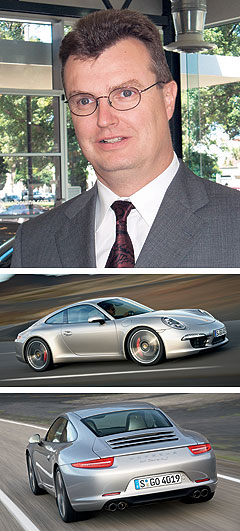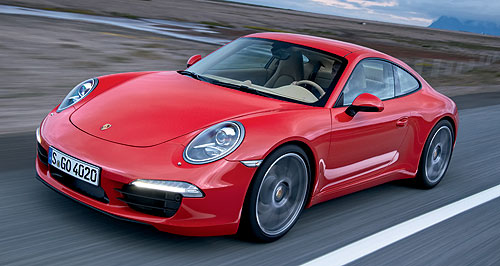New models - Porsche - 911New 911 to boost Porsche in 2012On the way: The new Porsche 911 will be officially released in Australia on March 10 next year. Porsche gets set for record year as seventh-gen 911 and other new models approach18 Nov 2011 PORSCHE Cars Australia expects record sales next year when the seventh-generation 911 Coupe arrives as the first in a series of redesigned Porsche models. Billed as the newest 911 since the original was launched in 1964, the 991-series will be officially released on March 10, before being joined by a redesigned Boxster convertible later next year, a new Cayman coupe in 2013 and the all-new Cajun compact SUV in 2014. On sale now with a starting price of $229,900 plus on-road costs for the entry-level Carrera manual, increasing to $263,100 for the more powerful Carrera S, the new 911 Coupe will be joined in mid-2012 by the redesigned 991-series Cabriolet, while production of the existing 997-series 911 Turbo and Carrera 4 models will continue until July next year, before they too are replaced. Despite the 2.9 per cent base price increase (3.9 per cent for the Carrera S, which now gains Porsche Torque Vectoring including a rear differential lock, plus satellite-navigation as standard), PCA says it plans to sell even more vehicles that it will this year. Porsche Australia set a sales record of 1380 in 2007, when the 911 attracted more than 500 buyers for the first time, but should easily better that this year. After 10 months of 2011, Porsche sales are up 9.4 per cent overall to 1216, thanks largely to a 45.5 per cent increase in Cayenne sales and despite 911 sales slumping by more than third. PCA managing director Michael Winkler told GoAuto the Australian operation would finish 2011 a few units ahead of its record. “In 2012, we will either set another new record or, in the worst case scenario, remain stable,” he said.  Left: PCA managing director Michael Winkler. Below: Seventh-generation 911. Left: PCA managing director Michael Winkler. Below: Seventh-generation 911.Mr Winkler said he expected the overall Australian automotive industry to remain above one million sales this year, “but not without a lot of financial incentives”, and expected the redesigned 911 to set new sales records. He said a number of 991-series orders had already been taken, but was confident most repeat 911 buyers would come forward following the first press reviews from this week’s global launch in California. “People want to know if Porsche has stuffed it up,” he said. “There will be those that say we’ve made it look ugly and those that say you didn’t change it enough, but at the end of the day they’ll buy it. “We were crucified for the 996 but it was the most successful 911 ever – the 997 outsold it but ran a year longer.” Mr Winkler said he doubted the base 911 Carrera’s downsized six-cylinder boxer engine (from 3.6 to 3.4 litres) would have an impact on sales, and that most 911 customers would continue to opt for the PDK automatic version over the cheaper manual model, despite its new seven-speed gearbox. “I don’t think it will be relevant because power and performance is up (by 3kW to 257kW or 350hp, with peak torque remaining at 390Nm, while the new 3.8-litre Carrera S engine now delivers 11kW more power at 294kW or 400hp and 20Nm more torque at 440Nm). “The fact of life is that engine sizes will go down across the industry in the search for efficiency.” As we’ve reported, the new 911 rides on a longer wheelbase for only the second time in history – this time by a substantial 100mm, shortening both front and rear overhangs and liberating more cabin space. Overall, however, the new model is 56mm longer at 4491mm, 65mm wider at 1873mm and 11mm lower at 1299mm. Despite the addition of up to 80kg of extra equipment, the larger and stiffer 991’s all-new aluminium-steel hybrid body is 80kg lighter than before. Thanks in part to aluminium doors, bonnet, guards, roof and engine cover, the new 911 Carrera S PDK has kerb weight of just 1415kg (down about 40kg), while the base Carrera PDK is about 45kg lighter than the car it replaces. The result is higher performance and lower fuel consumption, with the Carrera claimed to consume 16 per cent less fuel at just 8.2L/100km (Carrera S: down 14 per cent to 8.7L/100km) and emit 36g/km less CO2 at only 194g/km – a record low for any Porsche sportscar. At the same time, the Carrera is able to sprint to 100km/h in 4.6 seconds in dual-clutch PDK transmission guise (dropping to 4.4 seconds if the optional Sports Chrono package is selected and its Sport Plus button activated with launch control), while the Carrera S completes the 0-100km/h sprint in just 4.3 seconds (4.1 in Sport Plus mode). The fuel efficiency gains come in part from standard idle-stop systems for both models for the first time, as well as the new seven-speed manual transmission, which now also incorporates a hill-hold function. Other upgrades include six-piston aluminium mono-bloc fixed front brake callipers and larger 340mm rotors for the Carrera S, plus ‘PORSCHE’ rear badging for the first time. Also new is a seven-inch colour touch-screen PCM infotainment system, now including navigation and auxiliary media device input for both Carrera models. We’ve covered the new 911’s technical details previously – including its all-new interior and new electromechanical steering system, but PCA has now revealed full specification and equipment details both new coupe models. In Australia, the Carrera will ride as standard on 8.5x19-inch front wheels with 235/40 ZR19 tyres and 11x19-inch rear wheels with 285/35 ZR19 tyres, while the Carrera S gets 8.5x20-inch front wheels with 245/35 ZR20 tyres and 11x20-inch rear wheels with 295/30 ZR20 tyres. Both Carrera models will come standard with bi-Xenon headlights with washers, LED daytime running lights and indicators, a 4.6-inch TFT colour trip computer display, dual-zone automatic climate-control and 14-way power-adjustable seats with memory. Racing yellow has been added to the exterior paint colour palette, which also continues to include black, white and red (metallic paint remains a no-cost option), while grey, beige and blue join black as interior colour choices. Porsche Active Suspension management (PASM), including manually selectable Standard and Sport maps and a 10mm-lower ride height, is optional on the Carrera and standard on the Carrera S, as is Porsche Torque Vectoring (PTV), which works in conjunction with a mechanical rear diff lock on manual models and – in PTV Plus guise - an electronic rear diff lock on PDK models. Apart from PDK, options across the range will include dynamic headlights, a sunroof, tyre pressure monitoring, a Burnmester surround sound system, heated and ventilated seats,Porsche Ceramic Composite Brakes (PCCB), 20mm-lower PASM sports chassis and the new Porsche Dynamic Chassis Control (PDCC) system. As seen on the Panamera and Cayenne, the latter is an electronic roll-mitigation device that employs a hydraulic motor at each end to assist the anti-roll bars in minimising bodyroll while maintaining ride comfort.
 Read moreAll new models Alfa Romeo Alfa Romeo Abarth Abarth Alpine Alpine Alpina Alpina Audi Audi Aston Martin Aston Martin BMW BMW Bentley Bentley Chery Chery Brabham Brabham Chrysler Chrysler Chevrolet Chevrolet Cupra Cupra Citroen Citroen DS DS Dodge Dodge Fiat Fiat Ferrari Ferrari Foton Foton Ford Ford Great Wall Great Wall FPV FPV Haval Haval GWM GWM Honda Honda Holden Holden Hyundai Hyundai HSV HSV Isuzu Isuzu Infiniti Infiniti Jeep Jeep Jaguar Jaguar Lamborghini Lamborghini Kia Kia LDV LDV Land Rover Land Rover Lotus Lotus Lexus Lexus Maserati Maserati Mahindra Mahindra McLaren McLaren Mazda Mazda Mercedes-Benz Mercedes-Benz Mercedes-AMG Mercedes-AMG Mini Mini MG MG Nissan Nissan Mitsubishi Mitsubishi Pagani Pagani Opel Opel Porsche Porsche Peugeot Peugeot Ram Ram Proton Proton Rolls-Royce Rolls-Royce Renault Renault Saab Saab Rover Rover Smart Smart Skoda Skoda Subaru Subaru SsangYong SsangYong Tesla Tesla Suzuki Suzuki Toyota Toyota Volvo Volvo911 pricing
Motor industry news |
|
||||||















Facebook Twitter Instagram